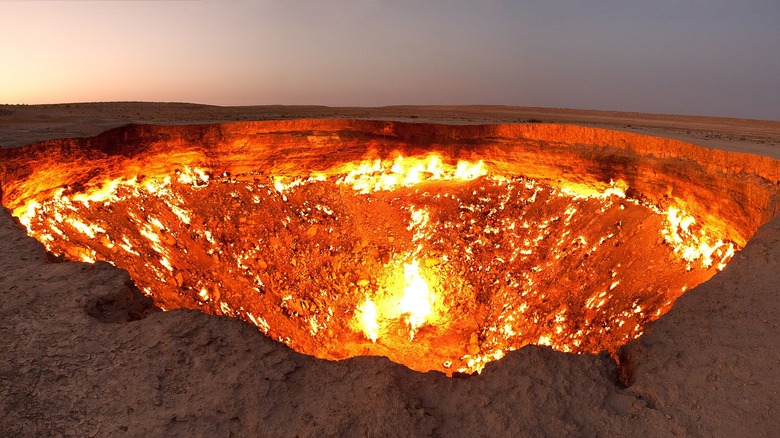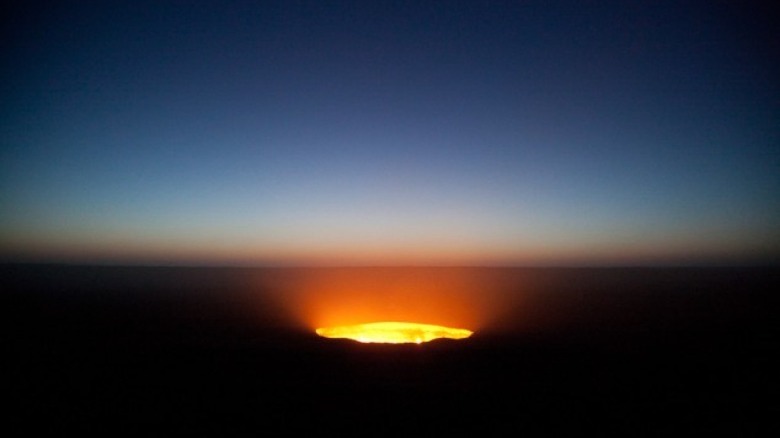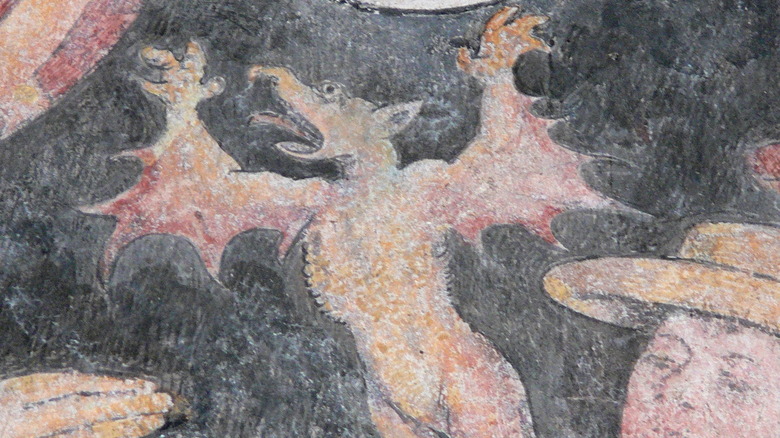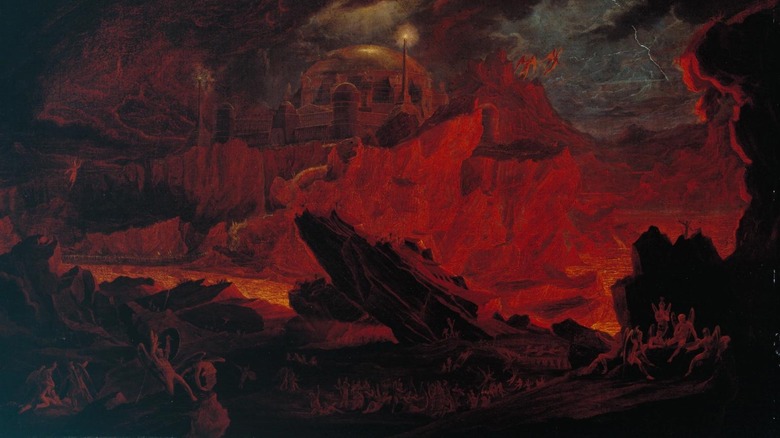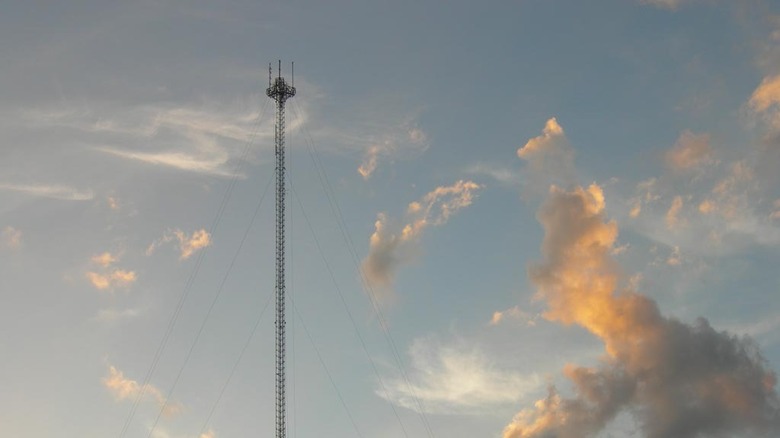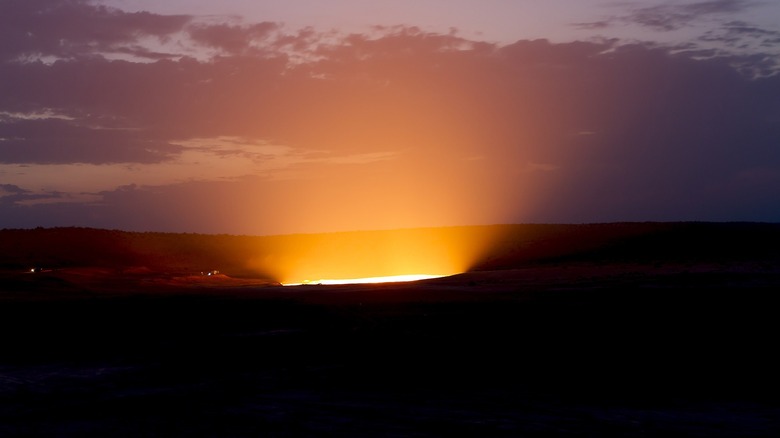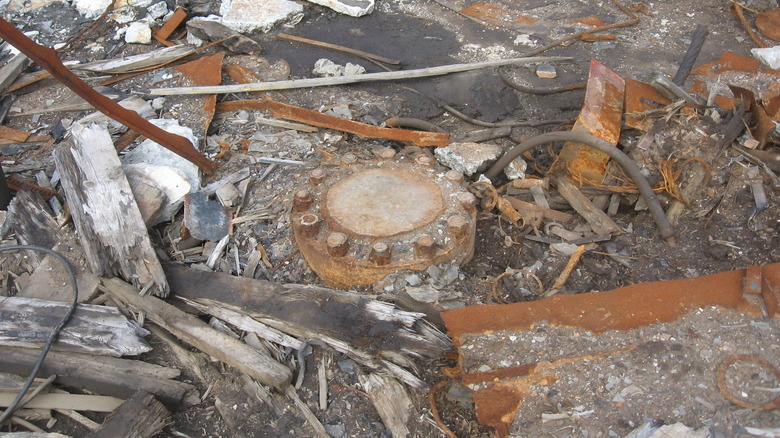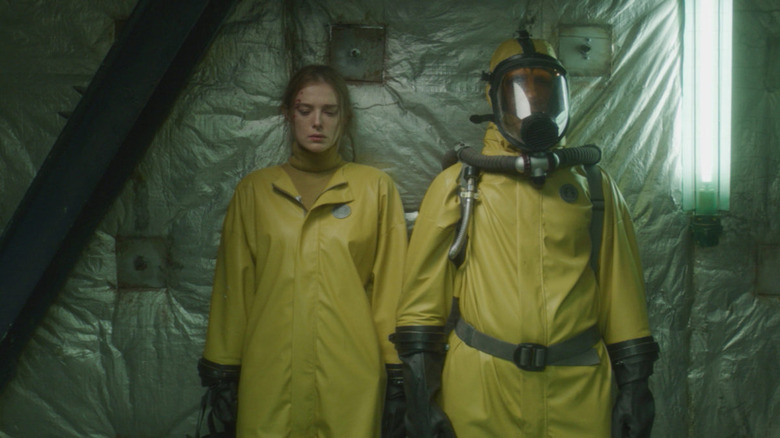The Untold Truth Of The Well To Hell
Depending on what circles you were moving in during the 1990s and beyond, you may have encountered the terrifying story of the Well to Hell. Perhaps it was breathlessly recounted in your church's bulletin. Maybe a relative forwarded it in an old-fashioned email chain to everyone in their inbox, including you. Or it could be that you heard about it late at night, from a wide-eyed friend or a deep-voiced radio announcer who traded in eerie tales.
Some of the details may differ from person to person, but the basic story remains pretty consistent. According to Skeptoid, the Well to Hell legend claims that it all started with a scientific project in 1989 Siberia. Researchers were attempting to break through the Earth's crust and into the liquid mantle when, at around nine miles deep, they unexpectedly broke through into a cavity. Someone had the idea to lower a heat-resistant microphone into the unseen cavern. They recorded a chorus of agonized human screams. Many personnel are said to have immediately fled the site in a panic, for the scientists had broken through to none other than Hell itself.
The life of the Well to Hell story has continued on since then in surprisingly persistent ways. Many might have assumed that the story, which seemed patently ludicrous to quite a few listeners and readers, would have petered out soon after its debut. But, whether by accident or design, this story has stuck around. Here's the untold truth of the Well to Hell.
The origin of the Well to Hell is complicated
The basic Well to Hell tale first appeared in late 1989 and soon began to proliferate from there, says Skeptoid. At least, that's when it was published and televised by the Trinity Broadcasting Network, a Christian broadcaster that vaulted the lurid tale to worldwide prominence. From there, it was picked up by other Christian publications and, given the increasing use of the internet at this point in history, was likely helped along by many forum posts and email forwards, too.
Deseret News reports that the Trinity Broadcasting Network did eventually publish an addendum of sorts to the first story in February 1990 in its print magazine. This update included a supposedly translated Finnish news story telling the tale. Yet, that came from a missionary newsletter in Finland, which itself was said to have originated from yet another unidentified newsletter in California. Not exactly a shining example of a primary source, as your high school English teacher might point out.
But going farther back than that proves difficult. There aren't any respected scientific journals from the time that published any such account, much less any primary sources in Russian. Skeptoid does note that Science magazine did publish a story about the Kola Superdeep Borehole in August 1989. However, this scientific project was taking place in the far east of the Soviet Union and was nowhere near Siberia; neither did anyone report demons or hellish screams from the borehole.
A fiery demon left the hole
Like any compelling story, regardless of whether or not it was strictly true, the legend of the Well to Hell has been continually reshaped over the years. Each variation seemingly came with new details to round out the story and add interest. Per Skeptoid, one version that cropped up almost immediately after the initial story included the extra detail of a chilling visual apparition. Specifically, as the tale goes, the shocked scientists who stuck around the research station after listening to the recording eventually bore witness to a glowing explosion of gas coming from the borehole.
Quickly, the gas resolved into the image of a demon while "I have conquered" blazed across the skies in Russian script. If all the screaming wasn't enough to convince readers of the first version of the story, then surely the dramatic details here would push at least a few others to believe. How can you disbelieve a demon blazing across the Russian skies, after all?
Other versions claim that a cover-up was soon put into action, despite the site's remote location. In this variant, medics quickly rushed in and gave the engineers and other staff on site a vaguely-defined drug meant to erase their short-term memory, adding a touch of "The X-Files" style government conspiracy to the legend. According to Pacific Standard, other publishers, including those in the breathless and oftentimes fact-checking-averse world of tabloids, were quick to reprint the story with their own variations.
The story struck some as nonsensical
Though it's clear that this story quickly convinced at least a few people, given how readily it spread both in and outside of religious circles, questions about the Well to Hell arose practically right away. After all, how did a drilling team in remote Siberia have access to a heat-resistant microphone that could stand temperatures of around 2,000 degrees Fahrenheit? They weren't, after all, known to be sound engineers.
Surprisingly to some, even Christian publications worked to debunk the story. Christianity Today published one of the first skeptical articles critiquing the story in July 1990, using rather damning language that reduced the whole thing to the realm of poorly constructed urban legends and rumors spread by ill-informed Christians. And Rich Buhler, a radio broadcaster who worked for Christianity Today, took it upon himself to dig pretty deeply into the matter.
According to Buhler himself, he and his staff were able to contact a daily newspaper in Finland that had published a reader letter with a similar tale. Said reader confessed that he had gotten it from a Christian newsletter in the country. Following the game of telephone even further, Buhler was told that this group had supposedly gotten it from another newsletter, "Jewels of Jericho," that was published by another Christian group ... in California. From there, the trail suspiciously petered out, with nary a hint of an original Russian source or first-hand witness to the events.
The Well to Hell was said to prove Biblical literalism
For many who wholeheartedly believed in the story, the Well to Hell was nothing less than a slam-dunk for Biblical literalism, says Skeptoid. Surely, it proved that not only was Hell real and part of the larger Christian worldview but that it was a literal place that would surely convince everyone once the story got out. After all, there was a recording of the very thing out there (though, at the time that the Well to Hell tale was first published, you'd be very hard-pressed to find anyone who had actually heard said recording).
Yet, this wasn't a clear win for either side, and not just because the Well to Hell legend was already tough to believe. Biblical literalism has almost always been one of the more controversial developments in Christianity, one that strikes at the heart of what it means to not just interpret the Bible, but what it means to be a faithful believer in the first place.
According to The Guardian, the idea that the Bible is the inerrant, flaw-free word of God stems largely from the Protestant reformation. It could well be that part of the proliferation of and controversy generated by the Well to Hell story has something to do both with the growth of the American evangelical Protestant movement in 20th century America (via Encyclopedia.com) and the questioning of just how an eternal Hell can fit into Christian theology centered on a loving God.
A Christian broadcaster was tripped up by a hoaxer
The story seems to have first appeared in 1989, when the Trinity Broadcasting Network printed and televised the tale. Yet, an investigation into their sources would have revealed that a man named Åge Rendalen had purposefully planted at least part of the story, intending to reveal how gullible some broadcasters really were.
If Trinity Broadcasting Network had a fact-checking department in the late 1980s and early 1990s, then it was poorly utilized. Or else it simply didn't exist, which at least partially explains why the Christian broadcaster was so easily fooled by one man named Åge Rendalen.
Now, to be fair, Rendalen doesn't claim to have invented the entire hoax of the Well to Hell. In fact, according to Skeptoid, he was actually inspired to his trickery by the initial story. Wondering just how far it could go, he claims to have invented the story of the demonic, gaseous being appearing out of the well. He sent the story off to Trinity Broadcasting Network, with a Norwegian newspaper clipping he claimed supported the story. Only, if someone had bothered to translate it, they would have only found a mundane news item about a local building inspector. Rich Buhler, who finally did the legwork to track down Rendalen, also learned that the Norwegian man had included contact information for a pastor friend in California, who was instructed to give up the hoax immediately.
The Well to Hell story was revived in 1998
For some, the Well to Hell story survived as proof of the existence of Hell or as a ghastly tale that may or may not have been true. But, even in the face of skepticism, you can't keep a good (or at least shocking) story down. Plus, in 1998, the newsletter and tabloid-ready legend of the Well to Hell got a boost from a legendary radio host.
Per Skeptoid, "Coast to Coast AM" broadcaster Art Bell replayed supposed audio from the scene in 1998, which was later rebroadcast in 2002. This was said to be the first time members of the public had heard the sounds supposedly recorded by the heat-resistant microphone way back in the late 1980s. A listener wrote in after Bell had already mentioned the story, claiming that their uncle had a copy of the recording, which they attached. Bell played the file on the air — it was, ultimately, a bunch of screaming human voices in what sounded like a low-quality transfer — and the legend was given new life.
Bell's combined popularity and notoriety as a radio host willing to give a platform to some of the weirdest of the weird surely helped get the story to new ears. As The Outline noted after Bell's 2018 death, he had an estimated audience of over 12 million. He also eschewed screening callers, instead preferring to talk to them on-air and largely unfiltered, no matter how "wild" their ideas seemed.
The sounds may actually be from a horror movie
Soon after Art Bell aired the eerie recording of screams from the Well to Hell, the file began to proliferate on the internet. Yet, for all that Bell's reach allowed the story to gain new traction, this also meant that the so-called "evidence" was now out there for further scrutiny. And, for those with access to audio processing equipment (or, really, a careful ear), the sounds really don't hold up. As YouTuber JC Wood demonstrates, it's fairly easy to show that the screams repeat themselves. No, not as if it's the same people screaming over the course of the file; instead, it's the same exact screams looped multiple times.
Though it's easy to dismiss the Well to Hell tale now as a pretty blatant hoax, there are a few things that haven't yet been cleared up. One of the biggest remaining mysteries is where the 2002 recording actually came from. It's pretty clear that it's digitally processed and looped, but the original source is still up for debate. Some claim that the sounds are from a rather schlocky 1972 Italian film, "Baron Blood," though Skeptoid notes that it could really be from any cheesy horror flick and still work against the Well to Hell believers.
There are other 'wells to hell' on the planet
Try to find the "Well to Hell" as it's outlined in the legend, and you'll be out of luck. No one's revealed evidence of a superdeep borehole located somewhere in the wilds of Siberia. However, there are some places across the planet that have arguably earned the same moniker. And while these spots aren't generally understood as portals to the underworld, they can be pretty diabolical-looking.
Take Turkmenistan's "Gates of Hell," also known as the Darvaza Crater. You can visit the spot in the Karakum Desert, though you may not really want to do so. It's not because the sinkhole in question is full of demons, but because it's actually full of perpetually burning methane gas. According to the BBC, no one's fessed up to lighting the naturally-occurring methane on fire, though some put the blame on Soviet geologists in the 1970s. Others say the sinkhole formed in the 1960s and the flames started about two decades later. Either way, it's an eerie sight that puts many in mind of the urban legend.
If that's a bit on the nose, there's Yemen's Well of Barhout (via Vice). The pit is about 367 feet deep and is unsettling enough that it's inspired plenty of local legends about evil spirits loitering in and around its depths. But spelunkers who descended into the cave didn't find demons or screaming hordes. Instead, they discovered colorful geological features and an apparently healthy population of snakes.
There is a superdeep borehole in Russia
If you were to widen your search for the Well to Hell by a few thousand miles, you'd find a Russian project that would seem a bit similar to the very basics of the Well to Hell.
The Kola superdeep borehole, located on a peninsula in eastern Russia near Finland, is the largest man-made hole on the planet. According to the BBC, it was started in the 1970s as part of a geological scientific race where scientists attempted to break through the on-average 18-mile thick crust and get a sample of the Earth's molten mantle. The Americans undertook "Project Mohole" and unsuccessfully tried to take a shortcut through the seabed off Mexico's coast, while other nations like Germany tried their hand at land-based drilling operations.
At the time, the Soviet Union got the farthest, eventually getting over 40,000 feet into the surface. But the nation was notoriously tight-lipped about the affair, lending an air of secrecy and conspiracy to the project. However, it's worth remembering that the Kola superdeep borehole is on the other side of Russia from Siberia, is only 9 inches wide, and never released any demons or hellish sounds. What's more, scientists never broke through to the mantle or any caverns, eventually giving up in the face of increasing sub-surface temperatures and malfunctioning equipment. Now, the research station above the borehole is abandoned, with only crumbling buildings and a rusted cover over the hole itself to mark the achievement.
Filmmakers have used the creepy story
Many filmmakers have been drawn to the lurid Well to Hell story. And, no, it doesn't matter that the Well to Hell has been pretty well debunked or that real-life counterparts like the Kola borehole are too small or well-explored to offer up much mystery.
The film that deals the most directly with the Well to Hell is 2009's "Nine Miles Down." Only, this time the drilling station is in the Sahara desert, perhaps to amp up hellish themes with a hot setting (via Cult Film Alley). A security worker arrives at the site, only to find it abandoned and filled with spooky set dressing, like a sacrificed jackal and messages written in blood on the walls. He finds one surviving scientist but, dealing with an apparently heavy psychological load from past and present trauma, starts to crack. At one point, the scientist — somewhat heavy-handedly named Jenny Christensen, or "JC" (get it?) — plays him a mysterious recording that might be screams from the damned.
If you like your borehole-based horror to be a bit more Lovecraftian and less overtly religious, then you may want to check out 2020's "The Superdeep." This Russian film posits that an unspecified superdeep borehole is actually part of an extensive underground research complex that's uncovered some eldritch horror deep beneath the earth. It's still pretty by the book and occasionally messy, at least according to RogerEbert.com, but it may scratch that Well to Hell story itch nonetheless.
